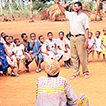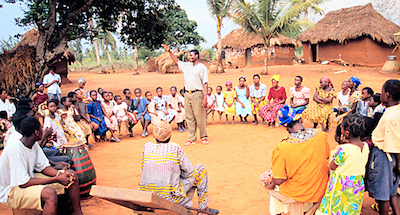Story and Song
An Innovative Church Planting Model

Harmattan winds have hovered over desert Africa for weeks, picking up Saharan sands and filling the sky of the Paga Na village with a brown haze. In this sand-gray dusk, the hushed, unnatural silence of the windswept, sub-Saharan village is spellbinding and disconcerting. Only a subtle breeze invades the soundless, palm-lined footpaths and the swept earth patios. But the silence of this southern Togolese village is about to end; the storyteller is coming!
And into the quiet hamlet the clear, resonant voice of his recitation will emerge, startling and powerful, heralded by drums. And when the departing flamingo sun finally sets, shirtless men leave their game of adí (mancala), the baguette sellers disburse, the tailors close up their makeshift stands, cranky bicycles are abandoned hastily, and yawning children resting on outdoor cots under coconut trees are wrestled from sleep. As the pulse of the drums intensifies and the storyteller takes his place on the low, carved bench, the village is mobilized and excitement permeates the air. The elders arrive in regal togas made of the wild, leaping colors of African cloth. Antoine, the animated storyteller–church planter exchanges ritual, formalized greetings with his audience. The fetish priestess, clothed in white and waving her horsehair amulet, acknowledges Antoine with penetrating eyes that speak of a past immersed in juju and prayer to the fetish. Night falls, the burning log crackles. They are ready for the story.
The listeners are electrified as the biblical story of creation begins: “In the beginning God created the heavens and the earth.” The poetic, melodious pattern of the story flows from Antoine’s lips. When he reaches the repeating phrase “and God saw that it was good,” he sings a song in call-and-response style. The song was written by Antoine’s friend Timothée, a believer gifted in music with a vision to reach out to his people. This song is designed to reinforce the story; the words of the song are: “In the beginning God created heaven and earth. It was empty, and darkness was over the surface of the deep.” The call and response is choreographed by the composer in a traditional style that glorifies God the Creator. As the villagers quickly memorize the song response and join Antoine, their voices become a chorus of blissful harmony.
Then dancing intercepts the story. The headman dances as well, thus placing his approval on the story and the event. The drum language continues. Amidst the steaming equatorial heat sitting stiffly in the air, the pulsating rhythm of the drum reaches to the stars and sounds deep into the tropical night. The storytelling and singing continue in this way. As the fire dims, the story ends. There is not one villager who wishes to leave that place. The story in this setting has connected them to the Word and to their history. It has involved and inspired them as they interact with the story through song and dance.
 GOD OF THE BIBLE IN STORY, SONG, AND DANCE
GOD OF THE BIBLE IN STORY, SONG, AND DANCE
As the weeks unfold, story upon story is told. Antoine returns with narration after narration followed by dynamic and involving dialogue with the listeners. The foundations of God’s story are laid before the people. There are stories of Abraham and his sons, stories of the prophets, stories of Jesus, stories of God’s community and the apostles, stories that address the felt needs of the community, and stories that change and reshape the listeners’ worldview. Extended family conversions will take place. In surrender to Christ, a fetish priest will destroy by fire his protective amulets, talismans, and jujus. A house church will be established. The story will become a vehicle of the Holy Spirit for conversion, for worldview change, for surrender of strongholds, and for discipleship because it is the word of God brought to life in the African context.
TRANSFORMED COMMUNITIES IN AFRICA
We are witnessing a cycle taking place throughout countless villages in the Volta Region of Ghana, in Togo, and Benin, where a church-planting movement has emerged under the leadership of Kwame.1 Kwame is an oral Bible champion and church planter trainer who has mentored Antoine and dozens of other storytellers. Kwame has faithfully executed everything he has learned about communication bridges to oral cultures. These bridges include Scripture storytelling, recitation, oratory, drama, and song. Kwame believes in the value of oral communication, because as he himself says, “It is the African way.” The oral arts are relevant and compelling. Western-taught evangelism methods of campaigns, literature distribution, and door-to-door outreach were rejected long ago in the difficult Muslim and animist environments of this area. Not only has Kwame implemented everything he has learned about the oral Bible, he has also trained church planters throughout the area to do the same. He has taught them the integration of the oral arts, a strategy in which the story becomes a focal point, which then meets song in a rhythm of speech, harmony, and movement. The holistic, integrated approach to story—tell the story, sing the story, dance the story, drum the story, and dramatize the story—has allowed the story to be owned by the local people. It enters into the collective memory of an entire community; it becomes a permanent part of the lives of the people.
Kwame has taught the grassroots church planters to follow a God-given cycle of evangelism and discipleship, overcoming obstacles by establishing rapport and respect with elders, headmen, and chiefs through humility and an attitude of serving. He has established guidelines for sowing, through selecting the right story needed for each community. He has taught them that evangelism is a process, and harvest may come not necessarily when an individual is willing to be extracted from his community, but when the entire family or even community is ready for con¬version. He has taught the church planters not to be negligent with discipleship but to use story, dialogue, and memorization to give the new believers their own foundation in the word of God—even though they cannot read and write. He has taught the church planters to establish leaders among those of oral cultures, empowering them with the stories of the apostles—each story of the book of Acts presenting a model of appropriate leadership behavior.
How can we help but rejoice to see such a church planting movement come to West Africa, a movement so in tune with the collective past of the culture and to the African way? In a place where the very rhythm of the earth lives inside villagers, where everything about them is art: from clothing to the very cadence of their walk. It is in this art of living—of rhythm, of sustaining joy amidst pain, this choreography of life—that creativity seems to emerge from deep within the very African soil. And when they rise to dance, the artist in every African emerges.
This article was condensed and reprinted with permission from Krabill, James R. et al, eds. 2013 Worship and Mission for the Global Church: An Ethnodoxology Handbook. Pasadena: William Carey Library, 229–231.









comments